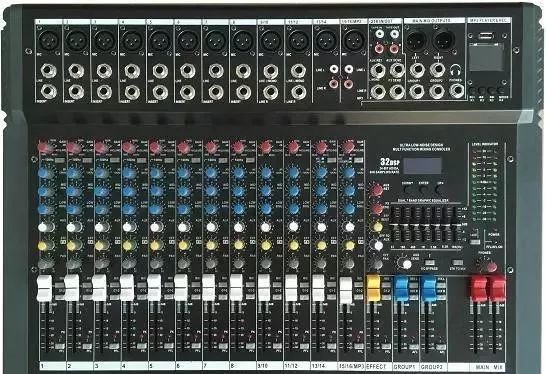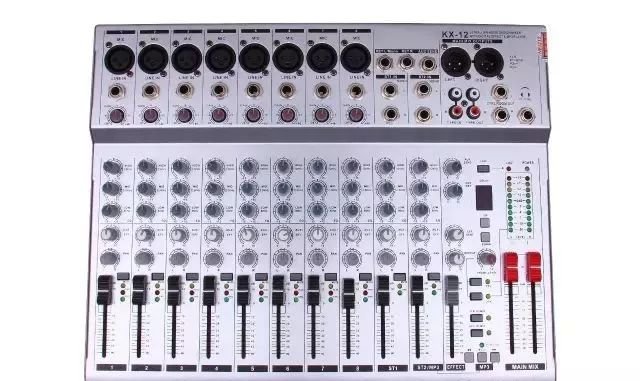The hotel’s engineering mixer is connected to the sound peripherals
Referring to the sound system, of course, we will first think of mixers, mixers, there will be many kinds of description methods, the most appropriate than the mixer likened to a sound system of the heart, the heart of the blood circulation, directly affect the performance of the entire system. The image of the mixer is like a large water treatment pool, we put a variety of sound source signals like running water into this large pool, and then in the pool for the flow of various water reasonable treatment, and finally from a variety of different channels flow out, the whole process is so simple. So the connection to the mixer is nothing more than input and output.
First, the line connection of the input port of the mixer:

The input signal of the mixer is divided into low-resistance microphone signal input and high-resistance line signal input. We can think of the distinction between low and high resistance as differences in water pressure or water flow rate.
For example high resistance input level is high as if the water pressure is very large, the water flow is more rapid, direct input to the mixing station this pool is appropriate, do not add any links in the middle to adjust the water pressure and water flow rate; We need to add a pump in the big pool, the low resistance of the low water pressure to it to increase, so that the water flow speeds up! So the mixer’s low-resistance input channel lines are built-in with dedicated circuit amplifiers that amplify low to the appropriate level. Such water characteristics to describe the low resistance signal and high resistance signal we should understand very well.
Only after the high resistance, low resistance can you select the correct wire for the corresponding connection, generally raise the platform input socket can be divided into 3 kinds:
1, TRS: high resistance input part is usually 6.35cm TRS stereo connector for balanced input, try not to use 6.35 TS monophonic ( sound) connector for unbalanced input, Most of the source playback devices we use today, such as VCD, DVD, MD, MP3, and most instruments, typically have high-resistance signals.
2, XLR: And low resistance is usually used XLR card non connector as a balanced input, now most wired microphones are usually connected to the mixer with a low-stop socket.
3, RCA: If there is a mixer with TAPE recording input, it is usually connected using an RCA lotus connector.
The problem that needs attention in the signal input section of the mixer: The input signal of the mixer can be divided into low and high resistance inputs in general, but how to accurately define whether a signal belongs to low or high resistance requires flexibility. For example, according to the standard, electronic piano, electric bass, electric ketch, etc. belong to the high-resistance signal, to use 6.35 plug input to the mixer can, but some places from the stage to the mixer between the cable are too long, the line resistance is large, coupled with lighting and other system interference so that the signal line of the background noise has been very large, even if not input any source signal, in the mixer to open the line input channel will have a lot of background noise, As described above: this line is a river, now the river sediment has been too much, at this time the line a lot of noise or can not be changed, and the line over there instrument volume has been opened to the maximum can not be increased, that is, the river can only give you so deep water, then how to do? If the high-resistance signal input is equal to the river water does not increase, water quality can not be changed, the sound quality of course can not be changed; It doesn’t seem very true, you can try it. I’m doing a lot of engineering now, the band is using the Cannon socket from the low-blocking input, although the surface may not look standard it is also a helpless way to reduce the noise of the band. So we have to be flexible and find the best way to work in practice.
Second, the line connection of the output port of the mixer:

Now the output part of the professional mixer has many sockets, and each has a division of labor, unlike the input part although the socket is many but relatively simple. Therefore, be careful when connecting the output signal. Usually, the main output port of the mixer still refers to the total volume output, group volume output, AUX output, etc., generally up the output port of the console by function can generally be divided into 6 parts:
1, group output: If we put the subwoofer through 1-2 groups to control the volume separately, then we can only output audio signal from the corresponding output socket of the mixer 1-2 group, the output of the group output mostly using TRS stereo socket for balanced output, of course, there are also cards The socket.
2, main channel output: L-R main channel is usually used XLR Card Nong balanced output, some small mixers also have TRS stereo socket instead.
3, AUX output: the most commonly used in mixers AUX output is to output acoustic effects, followed by to provide bands or singers with listening signals, of course, also open for other purposes, such as recording, as an auxiliary speaker signal. AUX typically uses ARS stereo socket output signals.
4, Direct direct output part: more professional mixer each input channel also has a “Direct direct output” socket, this socket can be provided to other equipment for recording, listening, etc., the mixer is usually used for each channel TRS stereo socket output signal. For example, a performance TV station needs to be live, live also live, if there are 20 source signals, then we can put these 20 sound source signals first into the TV station mixer, and then use the DIRECT direct output in the TV mixer to plug this in 20 source signals are then fed into the mixer for the live performance. Of course, now to be safe, the 20 source signals through the signal amplification distributor adjustment, distribution and then sent to the television mixer live-performance mixer, backup emergency mixer, recording mixer, or other equipment.
5, recording output: the general analog recording output signal socket is mostly using an RCA lotus connector. If it is a digital signal, it may use fiber optics, fire lines, and other digital output methods.
6, INS insert plug-out: The mixer is between the input and output, it uses a TRS stereo connector to connect. About INS insertion plug-in a lot of audio artists may not be used, it can be inserted into a mixer a certain input channel, marshaling channel or main (left and right channel) channel, the inserted channel of the sound signal processing alone. When using, connect with the TRS large three-core stereo connector by outputting the signal from the TRS large three-core stereo plug end, receiving the input of the device to be inserted, and then sending the signal from the output of the device to the ring end of the TRS large three-core stereo plug, and then flowing into the mixer. For example, we can use this method to insert an equalizer into the mixer 1and2 microphones, which is equivalent to truncating the water pipe of the 1and2 microphones and adding a water processor (equalizer), Then enter it into the mixer so that the tone adjustment works better.
The above is the connection of the mixer, whether it is the input port of the mixer or the output port, the socket and signal connection method used is these kinds, but the connection should be correct.
Third, the equalizer, pressure limiter connection:
1, equalizer: It is well known that the main function of the equalizer is to adjust the tone, adjust the sound field and suppress sound feedback, so in the current sound system equalizer is almost indispensable equipment, the current balanced input, and output parts are using balanced sockets, the best connection can be used XLR connector balance line, of course, can also be used The balancing line of the TRS connector.
2, pressure limiter: limiter is a kind of equipment to process audio signals, audio electrical signals can be dynamic compression or limit. Our main function now when using the limiter is to have it compress the high-level signal so that it can protect its subordinate audio equipment. It can be said that in a complete set of audio equipment, in addition to the mixer and equalizer, the pressure limiter is the most important peripheral equipment, so the normal situation of the lower pressure limiter should be placed in front of the amplifier, other peripheral equipment behind. The connection can be made using the balancing line of the XLR connector or the balancing line of the TRS connector.
Fourth, the connection of the electronic divider:
An electronic divider is an audio peripheral that can divide the audio signal of the 20Hz-20000Hz band into suitable and different frequency segments and then give it to the corresponding amplifier to promote the corresponding speaker. At present, the input part of the electronic divider is relatively simple, but the output part is more complex: there is treble output, mid-tone output, bass output, and so on. In the connection of the output of the bass signal and the output of the mid-high-pitched signal must not be confused, otherwise the treble signal to the bass speaker, bass signal to the tweeter, so that the sound system may not have sounded out, because the frequency is not right, bad will burn the speaker and other equipment! The electronic divider can use either the balancing line of the XLR connector or the balancing line of the TRS connector on the connection surface.
V. Connection of feedback suppressor:
In terms of device connections, there are also balanced lines with XLR connectors or TRS connectors, and the connection methods can be broadly divided into the following three types:
1, like the equalizer and other peripheral equipment in the same order in the sound system, so that the advantages of connectivity are: connection and operation are very simple, suitable for simpler systems. The disadvantage, however, is that this connection method also affects other source signals through the feedback suppressor when suppressing microphone sound feedback.
2, the use of inS in the mixer channel insert/plug out the interface, the feedback suppressor is singled in the corresponding channel, so that the advantages of the connection is: the maximum feedback suppressor can be adjusted, do not have to take into account the impact of other sources. The disadvantage is that with this connection method, a feedback suppressor can control up to 2 channels of the mixer, and the device utilization is too low.
3, the use of mixer group INS insert/plug out the interface, the feedback suppressor string in the corresponding group channel, the advantage is: can be integrated into this group of microphones for centralized processing, and will not affect other sources. All in all, because this method can make full use of the feedback suppressor, it is also the most used connection method.
Six, the connection of the time delayer:
Time extenders can delay the audio signal, generally used in some sound field space is large, need more than one set of speakers decentralized amplification system. Because in such a system sound from different locations of the speaker, when reaching the listener’s ear is divided, so to ensure the consistency of the sound, increase the readability of the sound, avoid the sound turbidity, edge sound, and drag tail, we need to use time delayer for phase processing. For the determination of the delay object, who is the delay? It is very simple, as long as you understand the following three points:
1, the first is people-oriented, more, no better audio equipment is also for people to serve, so in a sound field, we must first take the audience as the benchmark.
2, the second is to the main sound source, usually, that is, the main speaker and the main stage is located. Ideally, it would be ideal for the sound from the main source to be transmitted directly to the audience’s ears. However, due to the energy of the speaker, range, directionality, sound field sound pressure uniformity, and other reasons, so now most of the indoor sound systems also need to add some from the audience closer to the auxiliary soundbox.
3, the third point mainly refers to these from the audience closer to the auxiliary soundbox, that is, may need to be delayed processing of the speaker.
In most cases, the first-factor person is identified, the second factor is determined as the main source of the sound, and then the third-factor auxiliary soundbox is delayed. The speed of sound is approximately 340 meters per second, so the delay time is calculated based on the distance between the auxiliary speaker of the third factor and the main speaker of the first factor. Knowing that the delay object can properly connect the delayer, the connection is basically like an equalizer and other peripheral devices in the sound system need to delay the signal channel, using the XLR connector balance line or TRS connector balance line to connect.
Seven, the connection of the actuator:
The audio actuator is a harmonic generator, which uses the psychological acoustic characteristics of human beings to modify and beautify the sound signal. There are generally three ways to use a motivator for connections:
1, can be like the equalizer and other peripheral equipment in the sound system needs to stimulate the signal channel, such as in a mixer,1-2 group is vocal, if you want to stimulate the group of vocal processing, you can use the excitatory insertion / plug-out interface to connect to the mixer 1-2 group channel.
2. If comprehensive processing is to be carried out, then a booster can be threaded in the main volume output channel of the mixer or other output channels such as marshaling.
3, the actuator can also be like the effect of the AUX sent out of the signal, and then returned to the mixer, so that you can adjust which channels need to be stimulated processing, the strength of the need to deal with, and so on so that it is more flexible.
In terms of signal connection, the actuator is also connected using the balanced line of the XLR connector or the balancing line of the TRS connector.
Eight, the connection of the digital effector:
The effector is to process, manufacture a variety of sound field effects of the sound peripheral equipment, generally used for the processing of vocals, in most sound systems, if the vocals have not been processed by the effector will become no fullness and brightness, that is dry cognac no moisture. Now the latest effectors all use digital processing chips, so we also call them: digital effectors. The effector is less connected to the sound system than peripherals such as the equalizer, and in general, sends a signal from the AUX of the mixer to the effector’s input interface, and then returns the signal from the output interface of the effector to the mixer. In terms of signal connections, most are connected using the balanced lines of the TRS connector, and a few professional effectors are connected using the balanced lines of the XLR connectors. 、
Nine, the connection between the amplifier and the speaker
This should be familiar to everyone, but pay special attention to in terms of signal amplifier signal line to try to use the balance line, to minimize noise. Many audio engineers like to supply one or two signal lines to multiple amplifiers, but if there are more than four amplifiers, it is recommended to use signal amplifiers to separate a sufficient number of signal lines, no attenuation of the signal line for each amplifier alone, which can reduce system noise, reduce hidden dangers, improve the signal-to-noise ratio. In terms of power transmission, try to use thick and shorter speaker lines and reasonable wiring to shorten the distance of speaker lines, and pay attention to positive and negative poles to avoid short circuits.

